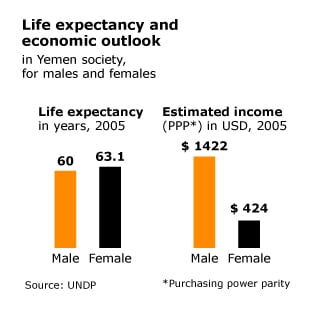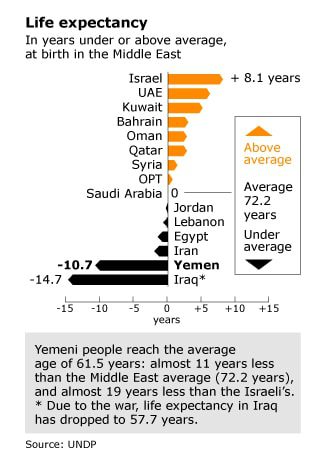
Introduction
Although it is urbanizing rapidly, Yemen is still a very rural country. Nearly three-quarters of the population leads a traditional life in mountain villages, some of them very remote. Poverty is widespread, social injustice is deep. Begging is common in the streets of the big cities. Women are denied an equal position in society. Health care is, however, improving rapidly.
Women
Yemeni law places women on an equal footing with men, but the execution of the law is often impeded by tradition. For instance, according to the law, women enjoy freedom of travel, but unmarried women who are not accompanied by a male relative are often turned back at airports. A married woman requires her husband’s consent to travel abroad. Women’s wages are only 30 percent of men’s. In a 2003 survey the UN concluded that 50 percent of all married women were subject to male violence. According to the World Health Organization (WHO), in 2003 an estimated 38.2 percent of women between 15 and 49 years of age suffered a form of genital mutilation. On the 2011 UN Gender Inequality Index, Yemen ranked an extremely low 146th.
That said, women hold much promise for Yemen. Girls often perform better at school, as a professional career is the best way to achieve independence. Girls have ample time to study, as they are not supposed to spend time outside the home. Most office work is performed by females, although their superiors are usually men. Women are generally not accepted in managerial and political positions. An opinion poll in early 2008 indicated that 53 percent of the respondents – of whom three-quarters were educated young males – opposed the election of a female mayor in Sanaa.
In 2006, the ruling General People’s Congress (GPC) made it one of its goals to integrate more women into the economy, setting a target of 15 percent of all government positions. A deadline for meeting this target has not, however, been established. Women constitute 22 percent of the total labour force. For the informal economy the figure is 38 percent, while the female segment of the formal public sector is only 9 percent. In 2010 the Human Development Report put the economic loss due to gender inequality at over 80 percent, compared with the Netherlands (17 percent), China (45 percent), Qatar (67 percent), and Iraq (75 percent).


Girls
Yemeni girls generally do not have much opportunity for self-development. The percentage of fourteen-year-old girls neither in school or employed in Yemen is the highest in the world: 44 percent (boys 18 percent), with an urban-rural split of 18 percent and 52 percent (World Development Report 2007).
In 2010, 567,702 primary-school-age children were not enrolled in primary of secondary school (source World Bank). In most families, girls are taken out of school at a young age in order to prepare for maternity. In the last decades, the average marriage age has risen from ten to fifteen years (for men, from 21 to 21.5), although 52 percent of girls still marry before they turn 18 (7 percent for boys) (World Development Report 2006).
One in seven girls marries before reaching the age of fourteen. Geographical variations are great. In al-Mukalla (on the south coast), the average marriage age was ten, while in al-Hudayda and the Hadramawt it was eight. In the larger cities, modernization is proceeding. Girls are now entering the public space in fast-growing numbers, although they remain veiled and are still a minority.
In 2008, an amendment proposed by the National Women’s Committee to raise the minimum marriage age to eighteen years was rejected by Parliament. The case of Nujood Ali, a nine-year-old Sanaa girl forcibly married to a violent man three times her age, drew global attention, after which a proposal to raise the marriage age to seventeen years was accepted by Parliament but then rejected for unknown reasons.
Education
Until the revolution of 1962, education was the privilege of the elite offspring of sayyids and qadis. Only a few schools existed. Since the revolution, schools have been built across the country, educating new generations. Today, 60 percent of all Yemeni adults are literate, with women catching up rapidly through adult-illiteracy-eradication centres in all major cities and towns.
Schools are located on hill tops, between villages. Primary pupils usually attend morning sessions, and the older children use the same classroom in the afternoons. Fees are limited to a few hundred riyals (a few dollars) per year, plus the cost of a school uniform. In 2009 over 80 percent of all children entered primary school, 40 percent continued into secondary schooling, and 10 percent received tertiary education.
The figures for boys are much higher than for girls. Most of the boys finish primary school. Of the girls, only half of the 64 percent (2005, up from 45 percent in 2001) who enrol actually finish school; the rest drop out at the first sign of sexual maturity. Secondary school enrolment is 27 percent for girls and 47 percent for boys (2009). Teachers come from abroad (traditionally from Egypt, Syria, and the Occupied Palestinian Territories).
It is unclear whether children belonging to the Akhdam underclass receive an education, and if so, how many. It is an unwritten rule that the Akhdam do not qualify for social services, because few Yemenis allow their children to mix with them.
Health
Institutional health care in Yemen was virtually non-existent until the 1960s. Many hospitals and outlying medical clinics have since been built, and thousands of doctors and health workers have been educated. Government expenditure on health care in 2009 hovered around 5 percent of total expenditure (world average, 10 percent), leaving gaps to be filled by foreign-aid organizations. Nearly a third of all public and private health-related expenditure is spent outside of Yemen. There are fewer than fifty physicians for every 100,000 Yemenis (world average, 112).
Many rural Yemenis live in isolated villages, hours from medical assistance. Knowledge of health issues in rural areas is still very limited. As a consequence, there are regular outbreaks of diseases such as tuberculosis and cholera, and periodic outbreaks of polio, Rift Valley fever, and bird flu. More than half the population (living in the foothills and along the coast) is prone to malaria, which causes 30,000 deaths a year. There are just over 2,000 reported cases of HIV/AIDS, although the regional office of the World Health Organization estimates the actual figure to be 23,000 (2009), of which only 237 receive treatment.
Yemeni women have for decades been the most fertile of the world, producing more than seven children on average. This figure has now dropped to 4.7 percent, due to continuing efforts by a broad coalition of political, religious, and tribal leaders to emphasize the advantages of the nuclear family. The use of contraceptives has risen from 10 percent to 25 percent in the last decade. Maternal death has dropped from 1.4 percent to 0.3 percent, as skilled health-care workers are now present at one in every four births. This latter is nearly double the figure of 1990, thanks to the training of thousands of midwives. Child mortality (under five years) has dropped from 142 per 1,000 in 1990 to 78 in 2009, of whom 68 were infants.
About half of all Yemeni children are underweight and a third severely stunted due to malnutrition. The widespread and increasing use of qat harms health, as it suppresses hunger, which results in eating and sleeping disorders. Furthermore, the increasing use of fertilizers and pesticides in qat cultivation has led to numerous health problems. Life expectancy for Yemeni women is 67 and for men 63, which is exactly the regional average but below world averages (71 and 68).


Poverty
According to international figures, Yemen is the poorest country in the Middle East and one of the poorest in Asia. It is perhaps more useful to compare Yemen’s standards of living with those of Africa. In 2011, Yemen ranked 154th on the UN’s Human Development Index of 187 nations, just above Senegal and Nigeria but below countries such as Papua New Guinea or Tanzania. Average annual income stands officially at USD 2,213, compared to Egypt USD 5,269 and Saudi Arabia USD 23,274. Almost half the population (45 percent) lives on less than 2 US dollars a day, and 17.5 percent on only USD 1.25 or less.
The disparities in Yemen are great, the top 10 percent making 30 percent of the national income, while the bottom 10 percent makes only 1.3 percent. The figures suggest that the rural population is poorest, but this might be misleading, as the rural population is largely self-sufficient, with home-grown produce to fall back on. The situation is worse for the urban poor, for whom there is no escape from hunger. Beggars roam the city streets. Hungry people wait for leftovers outside roadside restaurants. The situation has barely improved during the last two decades, any advance being outweighed by the high rate of population growth.
Nevertheless, there are many wealthy inhabitants and a growing middle class. A significant portion of the oil money, qat profits, and remittances from expatriate workers goes unrecorded but nonetheless fuels the informal economy. As a result, Yemen is dominated by its informal economy.
Crime
For many years, Yemen was considered one of the most heavily armed countries in the world, small firearms being popular among the tribal population. Tribal people armed with Kalashnikovs, pistols, or daggers have illustrated many news and country reports. Small firearms remain popular in rural areas, but a recent arms ban has ended the carrying of weapons in urban areas. It is now believed there are between six and nine million small firearms present in the country (previously fifty million), which equates to 40 guns per hundred people, which is half the figure for the United States.
The ban on weapons in urban areas has contributed greatly to the decline in crime, which has reportedly dropped by 35 percent. There is a slow increase in crimes perpetrated by unarmed people, but it remains a minor problem compared to other countries; Yemen has an official crime rate of 1.2 per capita, per 100 people. Theft and robbery are virtually non-existent; cities are very safe night and day.
Laws on crime and sentencing, based on Sharia, are harsh, with occasional public hangings of murderers, public flogging and hand amputation of thieves and robbers, and public stoning of adulterers. The number of prisoners varies between 3,000 and 14,000. As a result of the northern guerrilla conflict and southern unrest, increasing numbers of political prisoners are purportedly being held without charge or trial.
Yemen has often made world headlines with news of the kidnapping of tourists by tribal people. In the period between 1996 and 2001, there were 47 kidnappings of foreigners, involving 114 tourists and 43 expatriates. Yemeni kidnappings are, however, different from ‘ordinary’ criminal kidnappings.
The primary reason for the abductions is to pressure the government (and foreign oil companies) to build roads, schools, and medical facilities in neglected tribal areas. This is a continuation of an old tradition, according to which rulers held tribal sons in order to force tribal leaders into submission. The kidnapped tourists and expatriates are usually treated as guests and released unharmed. After two deadly kidnappings in 1999 (reportedly by al-Qaeda affiliates rather than by tribal people), the government became less lenient towards abduction.
Crime
For many years, Yemen was considered one of the most heavily armed countries in the world, small firearms being popular among the tribal population. Tribal people armed with Kalashnikovs, pistols, or daggers have illustrated many news and country reports. Small firearms remain popular in rural areas, but a recent arms ban has ended the carrying of weapons in urban areas. It is now believed there are between six and nine million small firearms present in the country (previously fifty million), which equates to 40 guns per hundred people, which is half the figure for the United States.
The ban on weapons in urban areas has contributed greatly to the decline in crime, which has reportedly dropped by 35 percent. There is a slow increase in crimes perpetrated by unarmed people, but it remains a minor problem compared to other countries; Yemen has an official crime rate of 1.2 per capita, per 100 people.
Theft and robbery are virtually non-existent; cities are very safe night and day. Laws on crime and sentencing, based on Sharia, are harsh, with occasional public hangings of murderers, public flogging and hand amputation of thieves and robbers, and public stoning of adulterers. The number of prisoners varies between 3,000 and 14,000. As a result of the northern guerrilla conflict and southern unrest, increasing numbers of political prisoners are purportedly being held without charge or trial.
Yemen has often made world headlines with news of the kidnapping of tourists by tribal people. In the period between 1996 and 2001, there were 47 kidnappings of foreigners, involving 114 tourists and 43 expatriates. Yemeni kidnappings are, however, different from ‘ordinary’ criminal kidnappings. The primary reason for the abductions is to pressure the government (and foreign oil companies) to build roads, schools, and medical facilities in neglected tribal areas.
This is a continuation of an old tradition, according to which rulers held tribal sons in order to force tribal leaders into submission. The kidnapped tourists and expatriates are usually treated as guests and released unharmed. After two deadly kidnappings in 1999 (reportedly by al-Qaeda affiliates rather than by tribal people), the government became less lenient towards abduction.
Latest Articles
Below are the latest articles by acclaimed journalists and academics concerning the topic ‘Society’ and ‘Yemen’. These articles are posted in this country file or elsewhere on our website:


















